Vintage Postcards of the Allan Line Steamship SS Virginian - GG Archives
Colorized Vintage Postcard of the SS Virginian of the Allan Line shown sailing near port. Postcard was postmarked in London in the early 1900s.
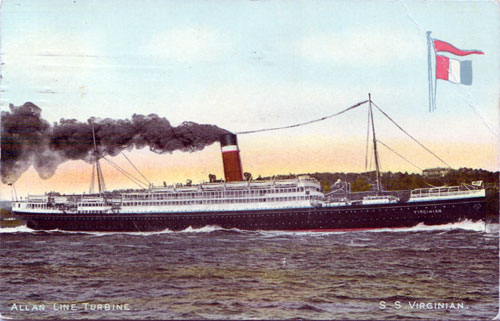
Archives Inventory Number: AMSA 743001022
Title: SS Virginian; Allan Line Turbine
Manufacturer: The Art Publishing Company
Date: Undated but circa 1905
Manufactured: Glasgow
Mfg PC Nbr: None
Postmarked: 29 Apr 190? Liverpool
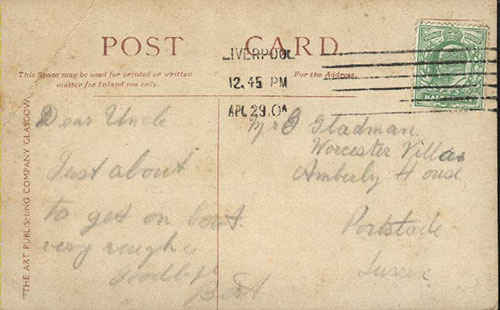
Beautiful Hands Across the Sea Series vintage postcard of the Allan Line SS Virginian, shown in color in open waters. The ship was states as 12,000 Tons, Turbine driven.
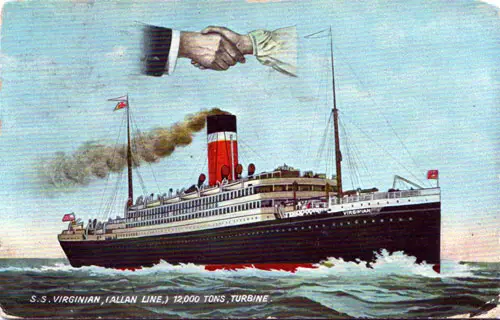
Archives Inventory Number: AMSA 738578894
Repository: GGA-ATL
Title: SS Virginian (Allan Line) 12,000 Tons, Turbine.
Manufacturer: State Publishing Co. Ltd.
Date: Undated but circa 1910
Manufactured: Liverpool, UK
Mfg PC Nbr: 202907
Postmarked: 18 Nov 1910 Halifax NS
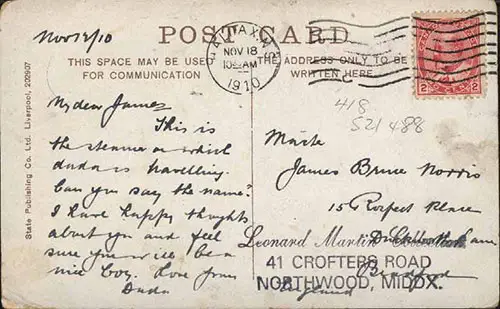
Text from Back of Card
Nov 12/[19]10
My dear James
This is the summer on which dad are "havething"? Can you say the name? I have happy thoughts about you and feel sure you will be a nice boy. Love from Dad
Addressed to Master James Bruce Norris
15 Rorfield Place
Bradford ???
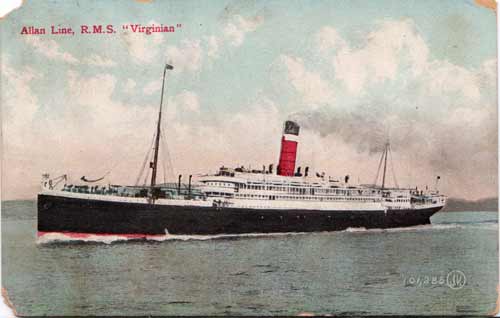
Allan Line RMS Virginian. PC-101285 JV. The Valentine & Sons Publishing Company, Ltd. Undated. Postally Used 14 Dec 1911.
The Making of the Virginian of the Allan Line
Just at the close of 1904, one of the most interesting products of the year was launched from the yard of Alexander Stephen & Sons (Limited), namely, the new turbine steamer Virginian, of 11,200 tons, for the Allan Line.
The Virginian is sister ship to the Victorian, launched by Workman, Clark & Company, Belfast, in August, 1904 and at present fitting out for sea, and they will be the first turbine liners to engage in the cross-Atlantic service.
Both vessels will be placed on the Canadian mail and passenger service from Liverpool, the Victorian sailing on her maiden voyage to Halifax, Nova Scotia, and St. Johns, N. B., on March 23, and the Virginian for the same ports on April 6. These vessels mark a notable advance in the progress of the steam turbine as applied to ocean steamers.
The Virginian's dimensions are 540 feet length overall, 60 feet beam, and 41 feet depth. She has been constructed under the supervision of the Allan Company's representatives, to the highest class in the British Corporation, and to the passenger requirements of both the British Board of Trade and the American laws.
She has accommodation for 1,650 passengers, 470 first-class, 240-second class and 940 third class. The vessel has a poop, long bridge, and forecastle, with large houses in the wells between the hatches, the tops of the poop and houses being arranged as promenades for passengers, and sheltered by boat decks, which again form promenades sheltered by awnings.
On the bridge deck is a long deck house containing first-class staterooms, with a wide alleyway on each side; above is the promenade deck with deck houses containing the first-class music and other saloons, sheltered by the boat deck, which is itself a wide promenade having the officers' quarters and navigating bridge at the fore end, and on each side a range of boats the full length of the deck.
The steamer is specially designed for the conveyance of the Canadian mails and passengers, five decks being fitted up for their accommodation, but she has also considerable cargo space in the holds fore and aft. The first-class dining saloon, at the fore end of the bridge, has accommodations for 200 persons.
The decorations are Georgian style, the paneling of mahogany, toned to a deep color relieved by inlays. A large and airy nursery has been provided for younger passengers. The second saloon, off the main deck, is arranged to seat over 200 passengers, and is pleasingly decorated. In the 'tween decks forward and aft of the cabin passengers are state rooms for the third-class passengers.
The deck below is also fitted up with staterooms for the same class, but with portable divisions, so that when not required these rooms can be removed. The cabin accommodation is heated throughout by steam, so arranged that each individual passenger can modify the heat to suit himself.
Electric lights fitted throughout, and there is also an installation of the Marconi telegraph. The turbines, which are being supplied by the Parsons Marine Steam Turbine Company (Limited), are to drive the vessel at a high rate of speed. Steam of high pressure will be supplied to the turbines by nine single-ended boilers fitted with forced draft.
The boilers and auxiliary machinery have been supplied from the engine works of the builders, Alexander Stephen & Sons (Limited). The turbine machinery is not yet in a condition to describe, but will be rapidly completed. Mr. Nathaniel Dunlop, senior partner of the Allan Company, says that in adopting the turbine method of propulsion they were aware that for ocean navigation it would require important and special adaptations, owing to the enormous power to be developed, and the need of great stopping and reversing power for maneuvering purposes.
Mr. Parsons examined the problem and satisfied both himself and them that it could be solved. They had no hesitation in accepting his assurance, and nothing has occurred in the process of construction to disturb their confidence in the system. He made this statement because a paragraph appeared some time ago in the American press to the effect that the turbines had not answered the expectations of the Allan Line, and had not come up to the contract power. That statement was actually issued before the turbines were made, and before any trials of their power were possible.
The turbine promised many advantages to travelers by sea. Its noiseless and uniform motion imparting a corresponding measure of steadiness to the ship in heavy weather. The speed, too, of these turbines on the Atlantic would reduce the time at sea, and, together with the shorter mileage of the Canadian route, and its land-sheltered navigation on the Canadian side, should make it a favorite line of travel to and from the American continent.
Excerpt from “Shipbuilding in Scotland in 1904” by Benjamin Taylor, Marine Engineering, New York, Volume 10, No. 5, May 1905, P. 212.
